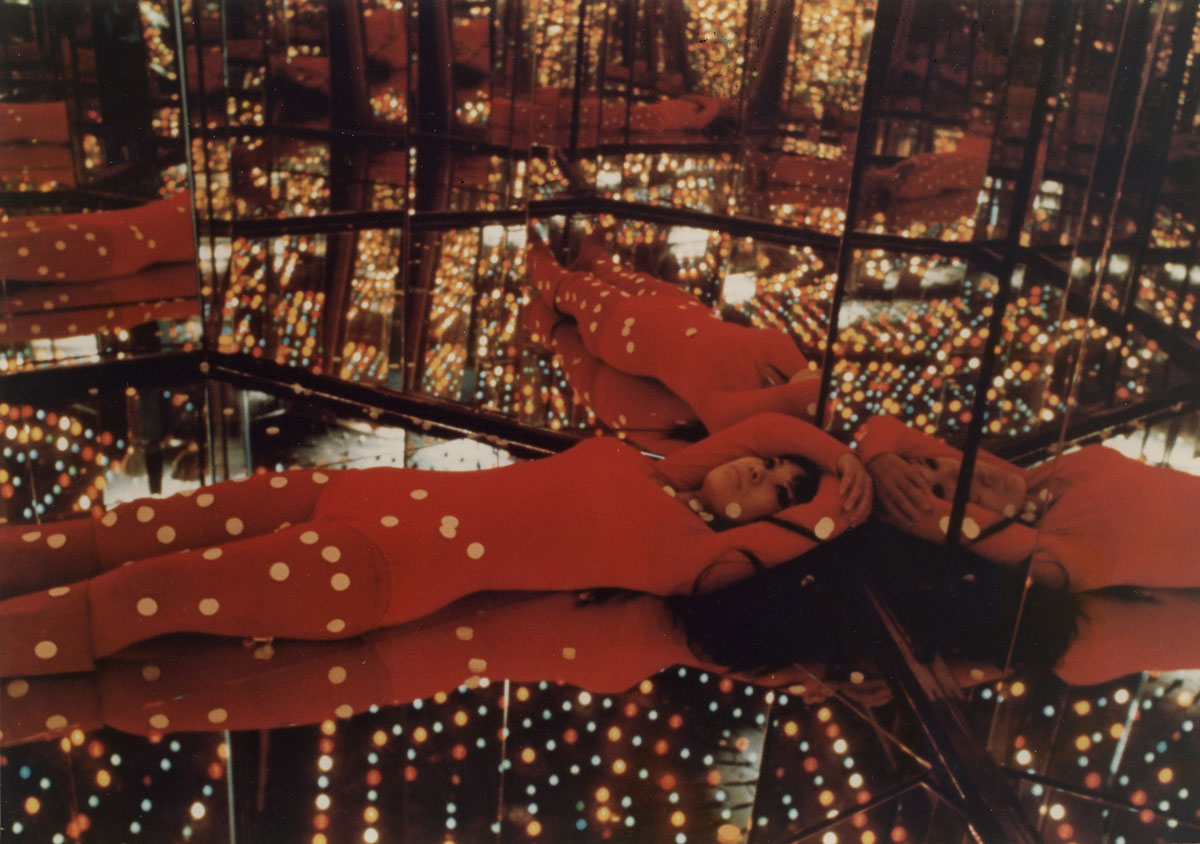The Hirshhorn Museum presents its permanent collection of Yayoi Kusama’s works, including two of her Infinity Mirror Rooms. The exhibition that entitled One with Eternity builds on Kusama’s 2017 Exhibition: Infinity Mirrors at The Hirshhorn Museum. This exhibition also shows Kusama’s early paintings, sculptures (Pumpkin (2016) and Flowers-Overcoat (1964), as well as photographs of the artist. One with Eternity is dedicated to honoring Kusama as a distinctive artist who explores its development across media.

Kusama’s Peep Show or Endless Love Show, 1966. Hexagonal mirrored room and electric lights. Installed at Castellane Gallery, New York, 1966. © Yayoi Kusama. https://hirshhorn.si.edu/kusama/the-exhibition/
Kusama’s Infinity Mirror Rooms will bring the audience to step into six captivating mirror rooms. The cube-shaped rooms are made of mirrors as their walls, the ceiling, and the floor. These mirrors produce endless reflections. Kusama filled the room with phallic red dots soft sculptures or colorful light dots. As the result, the room creates a dazzling, immersive, and breathtaking sensation of infinite space.
Kusama used mirrors first in the mid-1960s in her large-scale installations Infinity Mirror Room – Phalli’s Field 1965 and Kusama’s Peep Show – Endless Love Show 1966. Later, Kusama made other versions of mirrors rooms in 2011/2017 under the title Infinity Mirrored Room – Filled with the Brilliance of Life. Although speak different themes, all of Kusama’s series of Infinity Mirror Rooms remain to bring great experience that melted down the boundaries between subject and object.

Yayoi Kusama, “Pumpkin,” 2016, at the Hirshhorn Museum and Sculpture Garden. Courtesy of Ota Fine Arts, Tokyo/Singapore. © Yayoi Kusama. Photo by Cathy Carver. https://hirshhorn.si.edu/kusama/the-exhibition/
Pumpkin (2016) is Kusama’s large sculpture (6-foot-tall, 8-foot-wide). A Bright yellow pumpkin with different sizes of black dots all over its body radiates cheerful energy. This pumpkin is one of Kusama’s beloved motifs, and can even be an alternative to her self-portrait. The artist was inspired by her childhood memories when she grew up surrounded by her family’s seed nursery in Prewar Japan. For Kusama, the pumpkins are humble, amusing, and give poetic peace to her mind. She also considers the pumpkins as warm motifs that at times “feel human”.
Pumpkin, 1991, Screenprint in colors, on wove paper, © Yayoi Kusama https://www.artsy.net/artwork/yayoi-kusama-pumpkin-2365
Pumpkins also appear in Kusama’s works on paper. She depicts pumpkins in various colors and sizes, providing unique vibes in every painting. Kusama’s painting subjects span from flowers, butterflies, and mushrooms, to the reflection of water and sea. Across her different paintings, she always uses dense patterns of polka dots and nets to portray the subject. These repetition and accumulation patterns represent her anxiety and hallucinatory experiences that often appear as multiplying spots or nets that dominate her vision.
Kusama is acknowledged as one of the most important living artists who moved from Japan. She was trained at the Kyoto City University of Arts in a traditional Japanese painting style called nihonga. Kusama’s inspiration is American Abstract impressionism. She moved to New York City in 1958 and became a part of the New York avant-garde scene, especially in the pop-art movement. Through her artworks, she “fight pain, anxiety, and fear.”
In Tokyo, Kusama lives in a mental hospital, and every day she crosses the street to her studio to create her wonderful artworks. Kusama’s works have helped and transformed, not only herself, but also audiences around the world.
One with Eternity: Yayoi Kusama is on view at the Hirshhorn Museum from Apr 01 to Nov 27, 2022.

